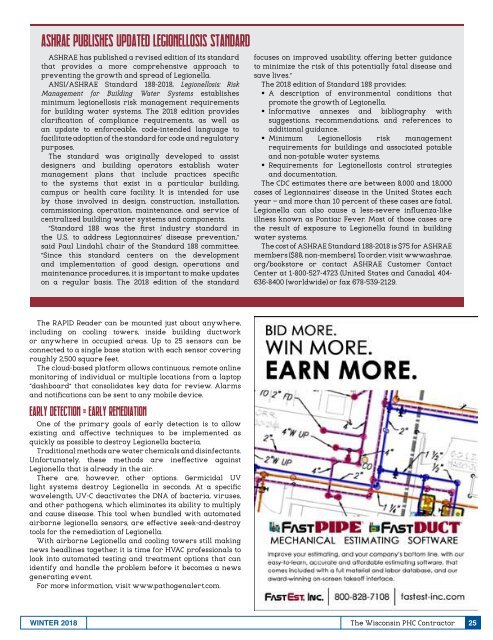Wisconsin PHC Contractor Winter 2018
Create successful ePaper yourself
Turn your PDF publications into a flip-book with our unique Google optimized e-Paper software.
ASHRAE PUBLISHES UPDATED LEGIONELLOSIS STANDARD<br />
ASHRAE has published a revised edition of its standard<br />
that provides a more comprehensive approach to<br />
preventing the growth and spread of Legionella.<br />
ANSI/ASHRAE Standard 188-<strong>2018</strong>, Legionellosis: Risk<br />
Management for Building Water Systems establishes<br />
minimum legionellosis risk management requirements<br />
for building water systems. The <strong>2018</strong> edition provides<br />
clarification of compliance requirements, as well as<br />
an update to enforceable, code-intended language to<br />
facilitate adoption of the standard for code and regulatory<br />
purposes.<br />
The standard was originally developed to assist<br />
designers and building operators establish water<br />
management plans that include practices specific<br />
to the systems that exist in a particular building,<br />
campus or health care facility. It is intended for use<br />
by those involved in design, construction, installation,<br />
commissioning, operation, maintenance, and service of<br />
centralized building water systems and components.<br />
“Standard 188 was the first industry standard in<br />
the U.S. to address Legionnaires’ disease prevention,”<br />
said Paul Lindahl, chair of the Standard 188 committee.<br />
“Since this standard centers on the development<br />
and implementation of good design, operations and<br />
maintenance procedures, it is important to make updates<br />
on a regular basis. The <strong>2018</strong> edition of the standard<br />
focuses on improved usability, offering better guidance<br />
to minimize the risk of this potentially fatal disease and<br />
save lives.”<br />
The <strong>2018</strong> edition of Standard 188 provides:<br />
• A description of environmental conditions that<br />
promote the growth of Legionella.<br />
• Informative annexes and bibliography with<br />
suggestions, recommendations, and references to<br />
additional guidance.<br />
• Minimum Legionellosis risk management<br />
requirements for buildings and associated potable<br />
and non-potable water systems.<br />
• Requirements for Legionellosis control strategies<br />
and documentation.<br />
The CDC estimates there are between 8,000 and 18,000<br />
cases of Legionnaires’ disease in the United States each<br />
year – and more than 10 percent of these cases are fatal.<br />
Legionella can also cause a less-severe influenza-like<br />
illness known as Pontiac Fever. Most of those cases are<br />
the result of exposure to Legionella found in building<br />
water systems.<br />
The cost of ASHRAE Standard 188-<strong>2018</strong> is $75 for ASHRAE<br />
members ($88, non-members). To order, visit www.ashrae.<br />
org/bookstore or contact ASHRAE Customer Contact<br />
Center at 1-800-527-4723 (United States and Canada), 404-<br />
636-8400 (worldwide) or fax 678-539-2129.<br />
The RAPID Reader can be mounted just about anywhere,<br />
including on cooling towers, inside building ductwork<br />
or anywhere in occupied areas. Up to 25 sensors can be<br />
connected to a single base station with each sensor covering<br />
roughly 2,500 square feet.<br />
The cloud-based platform allows continuous, remote online<br />
monitoring of individual or multiple locations from a laptop<br />
“dashboard” that consolidates key data for review. Alarms<br />
and notifications can be sent to any mobile device.<br />
EARLY DETECTION = EARLY REMEDIATION<br />
One of the primary goals of early detection is to allow<br />
existing and affective techniques to be implemented as<br />
quickly as possible to destroy Legionella bacteria.<br />
Traditional methods are water chemicals and disinfectants.<br />
Unfortunately, these methods are ineffective against<br />
Legionella that is already in the air.<br />
There are, however, other options. Germicidal UV<br />
light systems destroy Legionella in seconds. At a specific<br />
wavelength, UV-C deactivates the DNA of bacteria, viruses,<br />
and other pathogens, which eliminates its ability to multiply<br />
and cause disease. This tool when bundled with automated<br />
airborne legionella sensors, are effective seek-and-destroy<br />
tools for the remediation of Legionella.<br />
With airborne Legionella and cooling towers still making<br />
news headlines together, it is time for HVAC professionals to<br />
look into automated testing and treatment options that can<br />
identify and handle the problem before it becomes a news<br />
generating event.<br />
For more information, visit www.pathogenalert.com.<br />
WINTER <strong>2018</strong><br />
The <strong>Wisconsin</strong> <strong>PHC</strong> <strong>Contractor</strong><br />
25


















